The company originated in 1840 and, during the rest of the century,
became one of the biggest firms of japanners in the country. For
further information on the company and Henry Loveridge himself, follow
the link at the foot of this page.
This firm originally made japanware on papier mache and
on tin. As the japanning trade fell off during the second half of
the nineteenth century several firms are known to have moved into copper
and brassware. It seems that Loveridge's followed that course.
No records of the company are known to survive and no
catalogues issued by the company for brass and copper ware have yet been
found. An advertisement which illustrates some of their brass and
copper ware is shown on another page. This is a case where
archaeology (the surviving artefacts) has to be used to supplement the
very limited historical record.
It is by no means certain that all of Loveridge's goods
had a maker's mark on them. Indeed it would be surprising if this
were so: putting a trade or other mark on mass produced items was
not at all common before the last quarter of the nineteenth century.
Some japanned items have been found marked with the single word "Loveridge"
as has one cast iron cooking pot. Undoubtedly most items of that
sort were not marked. By the time brass and copper ware for
domestic use was being produced on a large scale, marking goods was much
more common. Although many surviving pieces of Loveridge's art
metalware do have identifiable marks on them that does not mean that all
of Loveridge's pieces are marked. Indeed identical items have been
found with one marked and the other not marked.
The following maker's marks have been noted:
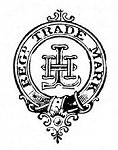 |
The trade mark on the left comes from an advert. It is
not clear if the belt with the words in it is really part of the registered
trade mark or whether what was registered was simply the letters "HL".
Note the curvilinear form of the serifs, which may have given the lead to
the trade mark used later. The commonest marking on pieces is the
simple elaborated letters shown to the far right. |
 |
Some Loveridge pieces have registered design numbers on
them. It should be remembered that this gives a date for the
design but not a date of manufacture. It is known that some
manufacturers used the same design for decades and there is no reason to
suppose that Loveridge's did not.
It is not known exactly when Loveridge's started to
make brass and copperware. The registered design numbers give some
indication of dates. It is certain that the company closed in
1927. It may be supposed that the items which incorporate cast
or wrought iron came into production at an early date, as the
company would be making use of its existing skills and equipment.
But it is not known how long these designs with iron continued in
production: it is just possible they were still being made in
1927.
The examples of Loveridge's products shown below and
on subsequent pages are arranged by function. No attempt is
made to arrange them by date. The items illustrated (which are a
chance, rather than a truly random, collection) may not be a
representative selection. But they do show something of the
range of Loveridge's brass and copper wares. They
also show that their designs covered a variety of styles, rather as
one would expect from a company headed by someone who was a salesman
with a good knowledge of the taste of the potential market but who
was also keenly interested in design. Some of them may also
contribute to the question of whether Dr. Christopher Dresser
designed for Loveridge or influenced their designs. (Except where
otherwise indicated the items come from a private collection in
Wolverhampton).
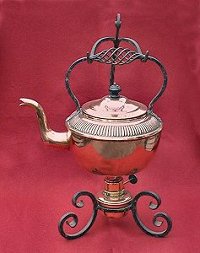 |
This copper kettle has a wrought iron handle and
stand. But note the simplification of the design of the ironwork
compared with the japanned kettle and stand shown on the front
page. A simplification in design may be the result of an
aesthetic decision but it may be motivated, to a greater or
lesser degree, by cost considerations. The spiral in the
handle was intended to keep the handle cool by dispersing heat.
|
 |
Another copper kettle in a similar design but
with both the kettle and the stand simplified, giving a very
neat appearance.
Photo by courtesy of Jonof. |
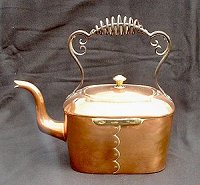 |
This copper kettle has an iron handle and a
brass knob and clasp. Note the exposed rivets, which some
say are a favourite motif of Dr. Dresser. There are other
aspects of the design of some of Loveridge's pieces which also
correspond with Dresser's design principles. But they can
also be explained in other ways and there is no convincing
evidence that Dresser designed for Loveridge's. |
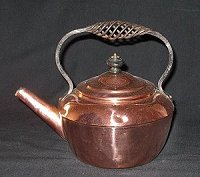 |
This copper kettle (with ebonised wooden knob) may be
the same one as that on the stand above. The design can either be
seen as showing the clean lines of a Dresser influenced design or as a
response to keeping prices down. |
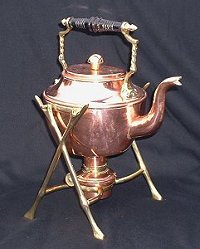 |
Copper kettle with stand and other elements in brass.
Some aspects of this design may be reminiscent of Dresser but other
aspects, such as the handle, argue against his influence.
(courtesy of the Angeline Johnson collection).
|
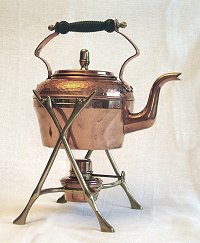 |
Copper kettle with a brass stand identical with that of
the kettle above. The kettle itself has similar design features
and the handle is much simpler, arguably producing a cleaner, more
coherent and more elegant design - not to mention a cheaper one. |
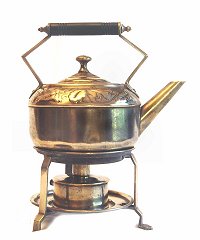 |
Brass kettle on stand. |
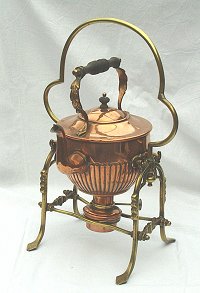 |
Copper kettle, with brass and ebonised wood handle, on a
brass stand. The stand can be easily taken apart by undoing 6
nuts.
The burner is clearly marked but no other part is. The lack
of marks, the use of cast brass in the handle and of nuts and
screws, not to mention the clumsiness of the overall design, suggest
that this is not by Loveridge.
Loveridge may well have sold burners to other makers. |
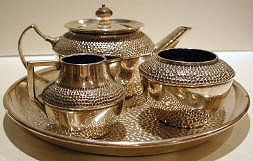 |
The marks of the bases of this tea set call it The
Pekin.
(courtesy of Greg Kolojeski) The set is also known in a
design in which gadroons replace the "hand beaten" areas of this set. |
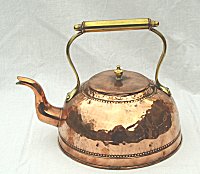 |
Copper kettle with brass handle. The beading, here
in two rows, is a typical Loveridge motif. |
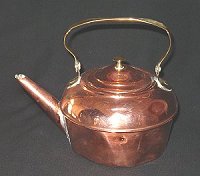 |
Copper kettle with brass handle. The handle is
pivoted at its base. This seems to be a case of designing down to
a price rather than to a design theory. Dresser's enthusiasm for
treating metal as simply as possible tends towards the same design
result. |
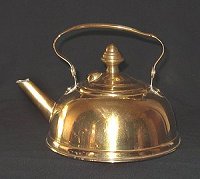 |
Kettle all in brass. The handle is pivoted at its
base. It is of very thin material and the handle may have been
distorted out of its original shape. |
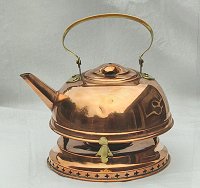 |
Copper kettle (knob to the lid missing) supported by
three hinged clips on a methylated spirits burner.
Kettles in light material and with a simple burner are often called
picnic kettles. They often have folding handles.
|
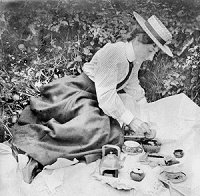 |
A picnic kettle, albeit not identifiable as by
Loveridge, in use. This wonderfully evocative photo is here by
courtesy of Martin Warner. It shows Lucy Trueman, sometime in the
1890s. It comes from a remarkable album of photos of Isle of Wight
life, many of which can be seen on Martin's web site at:
http://www.gmwarner.com/VictPhot.htm |
|

